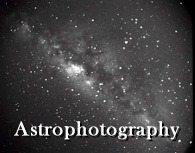Getting Started If You Already Own a Telescope
Here's some tips on what you can try if you already own a telescope. |

|
Prime focus astrophotography is not the easiest place to
begin unless you are imaging the moon. If you already have a telescope
on a half-descent mount and if it is already equipped with a tracking motor then I would
recommend the following pathway into astrophotography:
START WITH WIDEFIELD PHOTOS OF THE STARS
1. Mount an old film SLR ($US 20 second-hand) camera piggyback-method to your telescope.
Buy a camera ball socket ($US30) from a camera shop and somehow (use a light block of pine
wood if necessary) afix your camera securely to the top of the telescope, or failing that
remove the telescope and just mount the camera and a board of wood securely onto the
mount. The ball socket will allow you to point the camera ANYWHERE to take a photo
provided the mount itself is correctly polar aligned. If you have a DSLR camera like
the Canon 350D or similar then you are LAUGHING! Just switch on the scope's
tracking, click the camera and wait a few minutes for great results....
2. Use a FAST (f/4 or better) SLR lens on the camera that has focal length of 50 mm or
less.
3. During the day focus the camera at infinity (look at some distant
hills), put an infinity focus mark on the lens barrel so you can line it up in the night
time when you have to. You cannot focus correctly on stars by looking through the
viewfinder. You can get close, but you'll get no cigar... Focus is very,
very important.
4. Polar align your mount as best as you can (this is very, very
important).
5. Use the BULB setting on your camera to take a picture with your mount correctly polar
aligned and with the RA motor running. Use a cable-release ($US 15) for starting and
stopping each photo. Point the camera at the Milky Way if it's high in the sky or point at
some other area where there are lots of stars grouped together in the one area. Higher in
the sky and getting near overhead is the best.
6. Take several exposures. Check your iris is wide open at f/4 or wider. Check exposure is
BULB and that it works to give you a very long exposure. Use ISO400 or ISO800 film to
begin with. Take exposures of length 2, 4, 6, 8 and 16 minutes and get them developed ASAP
to check your methods. The results can be pleasing.
7. AFTER you do this try the same thing but this time guide the photos by looking through
the telescope and adjusting (only the big errors) with the motors - be really careful not
to bump anything.
8. Have fun.
9. Get yourself T-Thread and camera adapters ($40) for your camera suitable for
prime-focus.
NOW FOR PRIME-FOCUS. START WITH THE MOON
10. Make yourself a Bahtinov Mask
or a Hartmann Mask.
11. Under a half-moon or a quarter moon do a Rough Polar Alignment. A quarter moon
produces the easiest to get, most pleasing photos.
12. Use an eyepiece to centre a very bright star in your telescope's field of view.
13. Remove the eyepiece and connect up your camera at prime-focus.
14. Looking through the viewfinder of the camera use the Bahtinov Mask or Hartmann Mask
over the front of your telescope to get as close to good focus as you can.
15. Without changing focus slew to the moon.
16. Take a series of photos with various shutter speeds 1/100th second 1/250, 1/500,
1/1000...
17. Get pictures developed ASAP to see how you go. When you finish with the moon take some
exposures (1,2,3,4 minutes) of a bright DSO just to see the problems/issues with tracking
and polar alignment.
18. Have fun.
OTHER FUN
19. For planetary imaging, the moon and even for bright DSOs get a low-light video camera
or a web cam. The Mintron 62V1-Ex (color) is what I use ($US 250), but I read that TuoCam
and Meade's DSI are also very good. If you get a B&W video camera you will need to get
RGB ($US 100) filters if you want to create color images. (Color is not important
for the moon)
20. Get a 1.25" or 2" adapter to physically attach your video camera to the
focuser of the telescope.
21. Get some way to feed the video into your computer. The choice of camera and your
existing hardware will determine this. Some video cameras have composite (standard Video)
while others will have a firewire or USB connection. I use the Mintron's composite video
to view what's happening on TV and its S-video feed goes simultaneously to a camcorder
(Mini-DV) tape. I take the camcorder and connect it to my computer using the camcorder's
firewire connection. Use Astrovideo software (free trial) to capture images and Registax
(free trial) to stack images of the moon and planets.
22. Have fun.
If you don't have fun doing this then you may not last the distance...
All images and content of this website are
copyright (c)2005 Bill Christie. All rights reserved. |

